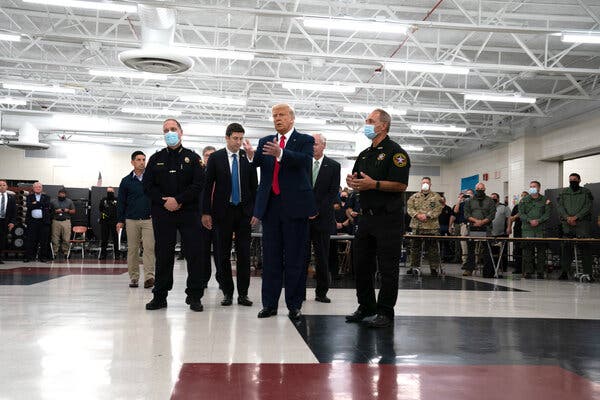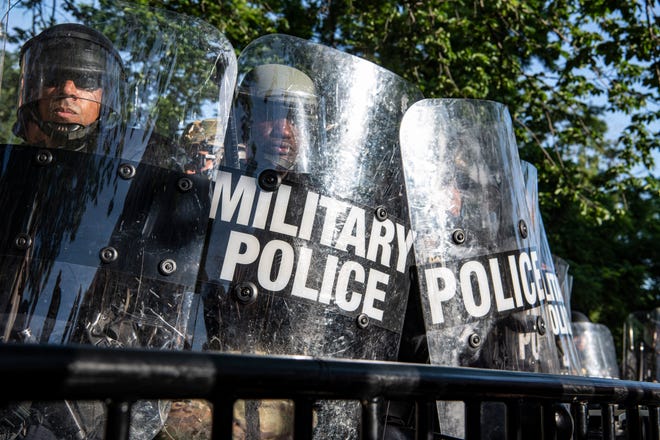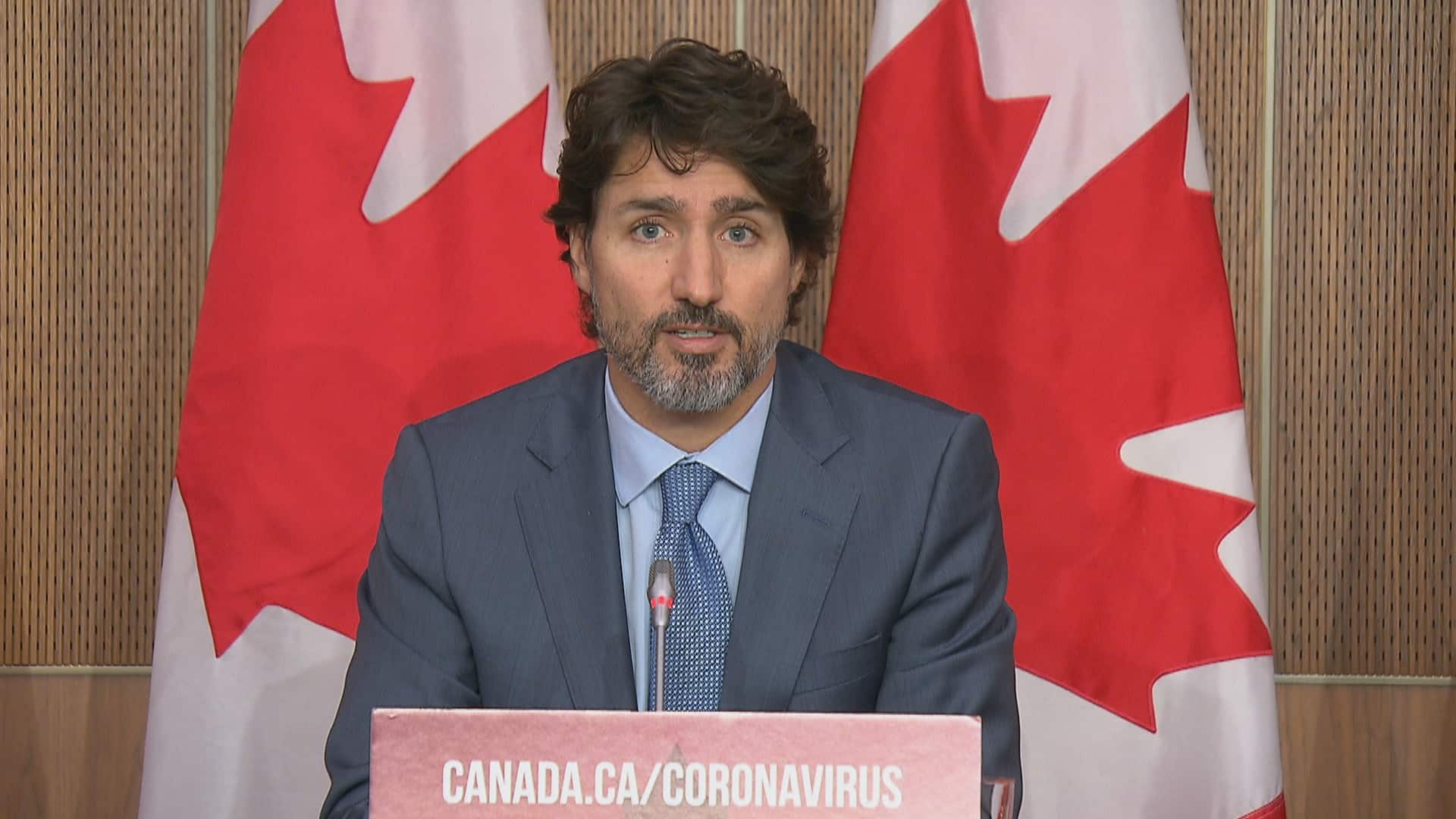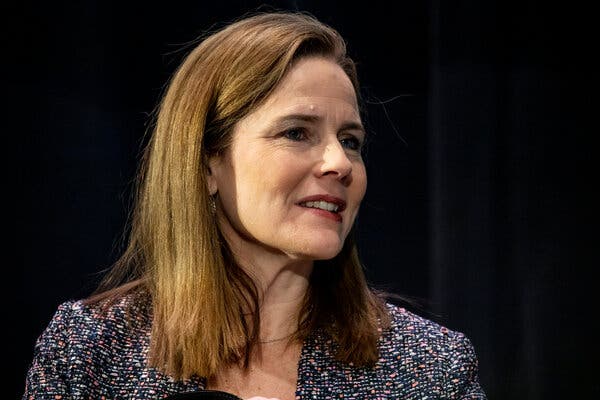Advertisement
The president directed officials to identify “anarchist jurisdictions” and move to withhold funds as he tries to build his campaign around the unrest that has accompanied racial justice protests.

President Trump has directed federal officials to find ways to cut funding to a string of cities controlled by Democrats, citing violence amid protests against systemic racism in policing, a move that threatens billions of dollars for many of the country’s largest urban hubs as the president makes the unrest a centerpiece of his re-election campaign.
Mr. Trump laid out the directive in a memo, released Wednesday, to Russell T. Vought, the director of the Office of Management and Budget, and Attorney General William P. Barr. It accuses state and local officials of abdicating their duties.
“Anarchy has recently beset some of our states and cities,” Mr. Trump wrote in the memo, mentioning a few cities specifically: Portland, Ore.; Washington; Seattle; and the president’s birth city, New York. “My administration will not allow federal tax dollars to fund cities that allow themselves to deteriorate into lawless zones.”
With polls showing him trailing his Democratic rival, former Vice President Joseph R. Biden Jr., Mr. Trump has tried to shift the public’s attention away from his administration’s failed response to the coronavirus pandemic and to what he depicts as out-of-control crime in New York and other cities. He has seized on an uptick in crime and has tried to blame it on local Democratic leaders.
The president has repeatedly sought to paint cities as hellscapes that only he can save, regardless of how limited the violent outbreaks have been during broader protests against acts of brutality by police officers against Black people.
The memo, which was titled “Reviewing Funding to State and Local Government Recipients That Are Permitting Anarchy, Violence and Destruction in American Cities” and was first reported by The New York Post, ratchets up Mr. Trump’s argument. But the move is almost certain to face legal challenges, and Democrats and city officials reacted furiously. Officials in New York said they were reviewing their legal options.
Bill Neidhardt, a spokesman for Mayor Bill de Blasio of New York, said on Twitter: “As much as Donald Trump wants New York City to drop dead, we will never let this stand. This has nothing to do with ‘law and order’. This is a racist campaign stunt out of the Oval Office to attack millions of people of color.”
An effort by Mr. Trump to curtail funding to so-called sanctuary cities was challenged in court, but a federal appeals court ruled this year that the administration was within its rights to withhold some funds, although three other appeals courts have ruled that the administration did not have the authority.
The memo appeared to be a dagger aimed squarely at New York, where Mr. de Blasio and the state’s governor, Andrew M. Cuomo, both Democrats, have been critical of the federal response to the coronavirus. The memo went on at length about the recent rise in crime in New York City, and Mr. de Blasio’s recent agreement to cut $1 billion in funding to the New York Police Department.
“To ensure that federal funds are neither unduly wasted nor spent in a manner that directly violates our government’s promise to protect life, liberty and property, it is imperative that the federal government review the use of federal funds by jurisdictions that permit anarchy, violence, and destruction in America’s cities,” the memo said.
It gives Mr. Barr 14 days to identify “anarchist jurisdictions” where officials have “permitted violence and the destruction of property to persist and have refused to undertake reasonable measures,” although it does not specify particular cities.
Mr. Vought has 30 days to direct “heads of agencies on restricting eligibility of or otherwise disfavoring, to the maximum extent permitted by law, anarchist jurisdictions in the receipt of federal grants,” according to the memo.
Among the factors that Mr. Barr is to consider in determining such jurisdictions are “whether a jurisdiction forbids the police force from intervening to restore order amid widespread or sustained violence or destruction,” whether a jurisdiction has pulled back law enforcement after being prevented access to a certain area and “whether a jurisdiction disempowers or defunds police departments.”
The revelation that Mr. Trump was considering such a move came hours after the New York Police Department released data showing that the surge in gun violence that has rattled the city this summer and intensified the debate over policing had continued at an alarming rate in August. Shootings more than doubled last month compared with August 2019, and murders rose nearly 50 percent, the police said.
The August numbers reflected a trend that many U.S. cities are contending with in a year that is already defined by a pandemic and civil unrest: a sharp rise in gun violence, murders and other crimes that has public officials grasping for explanations and scrambling to respond.
Still, Democratic officials said Mr. Trump’s move was not a solution but a political ploy.
Evan Hollander, a spokesman for the Democratic majority of the House Appropriations Committee, said Mr. Trump’s directive “intrudes on Congress’ power of the purse, would never stand up in court and is nothing more than a distraction from the fact that Americans are less safe under the Trump administration.”
A furious Mr. Cuomo, in an evening conference call with reporters, said the president’s letter was “another attempt to kill New York City,” where the president was long a resident and developer before officially moving to Florida last year. “Everything that he could possibly do in his power to hurt New York City he has done,” Mr. Cuomo said, adding: “The best thing he did for New York City was leave. Good riddance. Let him go to Florida. Be careful not to get Covid.”
Mr. Cuomo also derided the president as thinking he was “a king.”
“It’s cheap, it’s political, it’s gratuitous, and it’s illegal,” the governor said of the memo. Mr. Trump, he said, “better have an army if he thinks he’s going to walk down the street in New York.”
Mayor Jenny Durkan of Seattle said in an interview that the president’s call was a tactic that would further divide Americans when the country desperately needed leadership that could bring people together. She said she did not believe that the president could “defund” cities, calling the actions unlawful.
“It seems the only place where there is no respect for the rule of law is the White House,” Ms. Durkan said.
Mayor Ted Wheeler of Portland tweeted that Mr. Trump “continues to believe that disenfranchising people living in this country to advance his petty grudges is an effective political strategy.”
“The rest of us know it is dangerous, destructive, and divisive,” he wrote.
Violent crime always increases in the summer, but the rise has been extreme this year in New York. Since May, the city has recorded 791 shootings, an increase of more than 140 compared with the same period last year. The 180 murders recorded from May to August is more than 50 percent above the same period in 2019.
In August alone, there were 242 shootings in New York, compared with 91 the same month last year, and the number of murders rose to 53 from 36. As a result, the city surpassed 1,000 shootings before Labor Day, making it the worst year for gun violence since 2015, with four months left to go.
Still, this year’s numbers are well below where crime peaked in the 1980s and 1990s, and the recent rise in shootings and murders follows years during which the city saw violent crime drop to levels not seen since the 1950s.
The toll taken by the shootings has nonetheless been heavy. In August, the people who died from gun violence included the caretaker of a church in Brooklyn who was shot inside the church; a mother shot in the back of the head in front of a school in the Bronx; and a man struck by a stray bullet in Brooklyn while he was playing handball.
Despite the surge in gun violence, police data shows that arrest numbers have declined significantly over the summer while response times to 911 calls have risen sharply.
That has prompted some elected officials to call for an investigation into whether rank-and-file police officers are staging a work slowdown in response to the protests over police brutality and criminal justice reforms passed after the death of George Floyd in Minneapolis.
Police officials have challenged that idea, asserting instead that their resources were stretched thin as they have struggled to address other demands, including policing the protests.
The department’s ranks have also been thinned by the recent budget cuts cited by Mr. Trump and by a wave of retirements, leaving commanders scrambling to cover neighborhoods where violence is on the rise, officials said.
Reporting was contributed by Emma G. Fitzsimmons, Mihir Zaveri, Edgar Sandoval, Mike Baker and Emily Cochrane.




